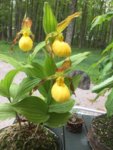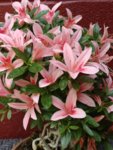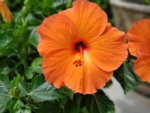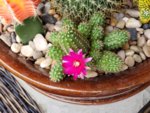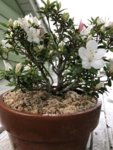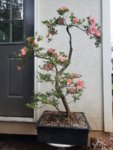You are using an out of date browser. It may not display this or other websites correctly.
You should upgrade or use an alternative browser.
You should upgrade or use an alternative browser.
Flowers 2019
- Thread starter atlarsenal
- Start date
Leo in N E Illinois
The Professor
- Messages
- 11,338
- Reaction score
- 23,278
- USDA Zone
- 5b
Wow, that is spectacular.
Cyp pubescens?
looks almost like a Cyp kentuckiense hybrid. (edit - after looking at my Cyp photos, I think yours is probably all pure Cyp pubescens, unless of course, you know the parentage).
I used to have Cyp (kentukiensis x microsaccos) but lost it a few years back.
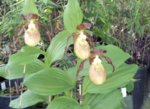
I kept a Cyp pubescens going for 10 years in a gallon nursery pot, but also lost it at some point. I tend to screw up with winter. In a pot it is difficult to get things right. In the future I will try ground growing with them.

Also had Cyp regina at one time


What is great about Cypripediums, is that now they are mostly propagated by seed, and cultivation is becoming easier as seed populations are definitely easier to grow in containers than wild collected plants. Knowledge of how to handle them has come a long way. I would do better with them now, as I know more now too. Just have not tried in the last 10 years.
Cyp pubescens?
looks almost like a Cyp kentuckiense hybrid. (edit - after looking at my Cyp photos, I think yours is probably all pure Cyp pubescens, unless of course, you know the parentage).
I used to have Cyp (kentukiensis x microsaccos) but lost it a few years back.

I kept a Cyp pubescens going for 10 years in a gallon nursery pot, but also lost it at some point. I tend to screw up with winter. In a pot it is difficult to get things right. In the future I will try ground growing with them.

Also had Cyp regina at one time


What is great about Cypripediums, is that now they are mostly propagated by seed, and cultivation is becoming easier as seed populations are definitely easier to grow in containers than wild collected plants. Knowledge of how to handle them has come a long way. I would do better with them now, as I know more now too. Just have not tried in the last 10 years.
Cadillactaste
Neagari Gal
ABCarve
Masterpiece
Those are quite the beauties. I have a real soft spot for lady slippers. Mine are pubescens. This is my first try and not sure what to expect. My plan is to treat them like my trees. Water every day, take it in around Thanksgiving, store in my unheated garage. There’s a guy in Ohio that specializes in these and has Asian varieties that have very large flowers. He told me I couldn’t grow them in a bonsai mix. I’ll see how they do and if they grow well enough to divide I might put some in the ground. Finding the right spot around here is difficult as they may be swallowed up and never seen again.Wow, that is spectacular.
Cyp pubescens?
looks almost like a Cyp kentuckiense hybrid. (edit - after looking at my Cyp photos, I think yours is probably all pure Cyp pubescens, unless of course, you know the parentage).
I used to have Cyp (kentukiensis x microsaccos) but lost it a few years back.
View attachment 243065
I kept a Cyp pubescens going for 10 years in a gallon nursery pot, but also lost it at some point. I tend to screw up with winter. In a pot it is difficult to get things right. In the future I will try ground growing with them.
View attachment 243067
Also had Cyp regina at one time
View attachment 243068 View attachment 243069
What is great about Cypripediums, is that now they are mostly propagated by seed, and cultivation is becoming easier as seed populations are definitely easier to grow in containers than wild collected plants. Knowledge of how to handle them has come a long way. I would do better with them now, as I know more now too. Just have not tried in the last 10 years.
LanceMac10
Imperial Masterpiece
LanceMac10
Imperial Masterpiece
ABCarve
Masterpiece
LanceMac10
Imperial Masterpiece
American wisteria??
95% sure. Bought at Bonsai West a long time ago. Finally growing/multiplying flower buds.
In the ground, it will need to be moved soon. But doubt it won't come back.
Leo in N E Illinois
The Professor
- Messages
- 11,338
- Reaction score
- 23,278
- USDA Zone
- 5b
Those are quite the beauties. I have a real soft spot for lady slippers. Mine are pubescens. This is my first try and not sure what to expect. My plan is to treat them like my trees. Water every day, take it in around Thanksgiving, store in my unheated garage. There’s a guy in Ohio that specializes in these and has Asian varieties that have very large flowers. He told me I couldn’t grow them in a bonsai mix. I’ll see how they do and if they grow well enough to divide I might put some in the ground. Finding the right spot around here is difficult as they may be swallowed up and never seen again.
Bonsai mix is not as bad as might be suggested by orchid people. What kind of fertilizer you use? If you are strictly organic, in the bonsai mix, the accumulation of organics might actually be good. Water quality plays in it too, if you use mainly rain water, you will have better luck. The handful of long term successful in container growers I saw used larger diameter azalea pots. 12 inch diameter pots that were only 6 inches in height. 3 gallon nursery cans and larger, often cut down to 6 or 8 inch heights. You want enough volume that soil temperature does not change too rapidly. Also, plant a slow growing, mild mannered grass or sedge to share the pot with the Cyp. Prairie Dropseed, Sporobolus sp. is one that is used, some of the smaller Caex and Juncus species. Key that is not be an overly aggressive grass. This has helped. These are tricks I will try again the next time I try Cyps.
I have used perlite - fir bark blend, heavy on the perlite. Just a touch of peat moss and chopped to short pieces long fiber sphagnum moss. A soft and fluffy mix. I have added Kanuma, it seemed to be okay as a component.
As I think about it, organic fertilizer would be the way to go, be sure to supplement with Kelp extract.
ABCarve
Masterpiece
I usually use both organic and dyna grow but I’ll give the organic only a try. However I can’t do the nursery pot thing. Beautiful plants in ugly pots is not an option for me. I’ll try to conjure something up this winter if they make it through this growing season. What’s the purpose of the grasses??Bonsai mix is not as bad as might be suggested by orchid people. What kind of fertilizer you use? If you are strictly organic, in the bonsai mix, the accumulation of organics might actually be good. Water quality plays in it too, if you use mainly rain water, you will have better luck. The handful of long term successful in container growers I saw used larger diameter azalea pots. 12 inch diameter pots that were only 6 inches in height. 3 gallon nursery cans and larger, often cut down to 6 or 8 inch heights. You want enough volume that soil temperature does not change too rapidly. Also, plant a slow growing, mild mannered grass or sedge to share the pot with the Cyp. Prairie Dropseed, Sporobolus sp. is one that is used, some of the smaller Caex and Juncus species. Key that is not be an overly aggressive grass. This has helped. These are tricks I will try again the next time I try Cyps.
I have used perlite - fir bark blend, heavy on the perlite. Just a touch of peat moss and chopped to short pieces long fiber sphagnum moss. A soft and fluffy mix. I have added Kanuma, it seemed to be okay as a component.
As I think about it, organic fertilizer would be the way to go, be sure to supplement with Kelp extract.
ABCarve
Masterpiece
They are immortal. I have one that was seemingly killed after two polar vortex’s in a row. It seems every time I think it’s gone, the next year it pokes up. “Hi, remember me”!!95% sure. Bought at Bonsai West a long time ago. Finally growing/multiplying flower buds.
In the ground, it will need to be moved soon. But doubt it won't come back.
LanceMac10
Imperial Masterpiece
Leo in N E Illinois
The Professor
- Messages
- 11,338
- Reaction score
- 23,278
- USDA Zone
- 5b
Hack Yeah!
Omono
Similar threads
- Replies
- 0
- Views
- 562
- Replies
- 1
- Views
- 317


